Business Law: Contractual Agreements and Promissory Estoppel
VerifiedAdded on 2024/06/28
|7
|1873
|376
AI Summary
This case study explores the legal principles of contract formation and promissory estoppel in the context of employment law. It examines the scenario of Frank, who advertised his car for sale, and the various offers he received. It also analyzes the situation of Renee, an employee who was promised a salary increase by her employer, but the promise was not fulfilled. The analysis delves into the elements of a valid contract, the concept of invitation to treat, and the doctrine of promissory estoppel, highlighting the legal implications of these principles in real-world scenarios.
Contribute Materials
Your contribution can guide someone’s learning journey. Share your
documents today.
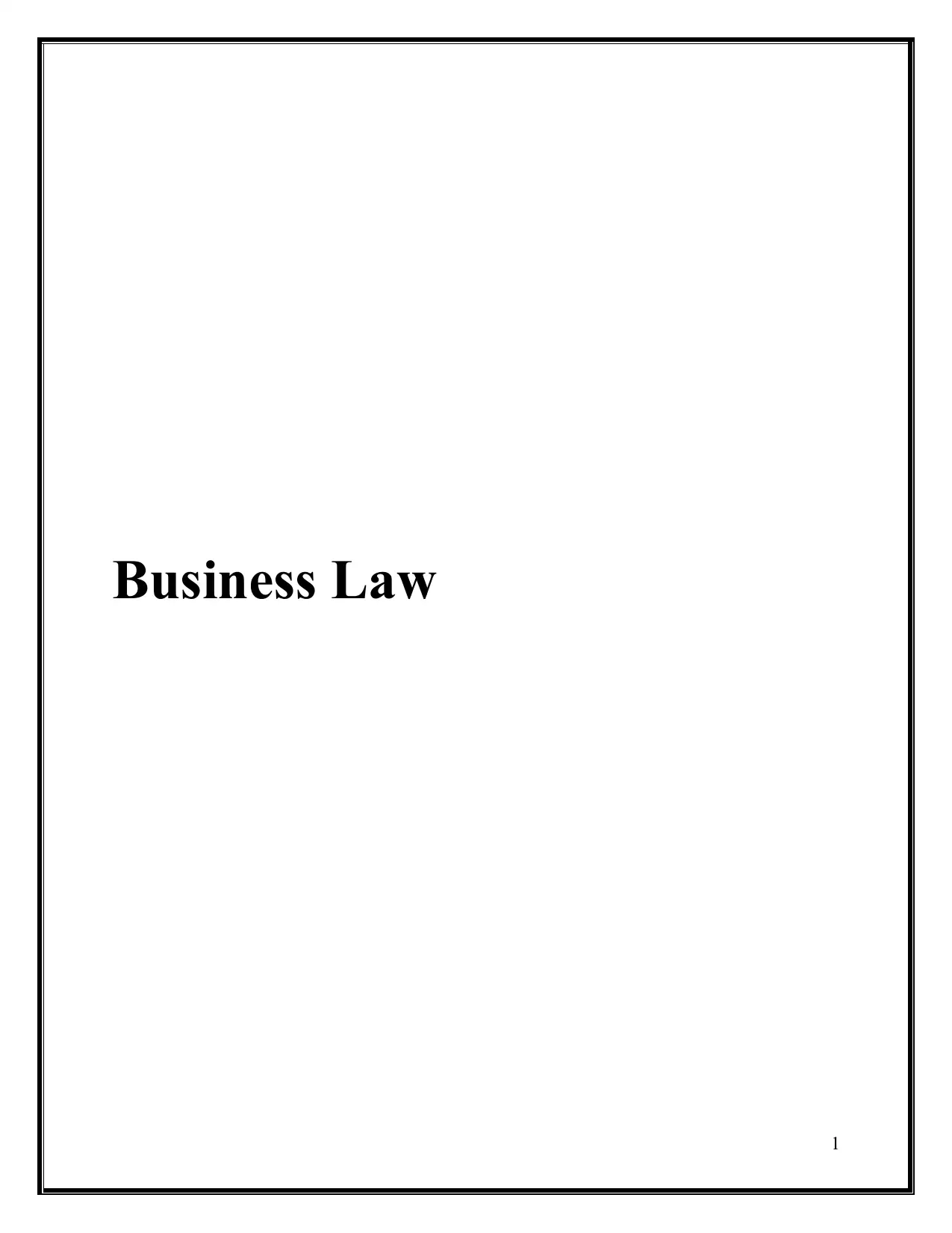
Business Law
1
1
Secure Best Marks with AI Grader
Need help grading? Try our AI Grader for instant feedback on your assignments.
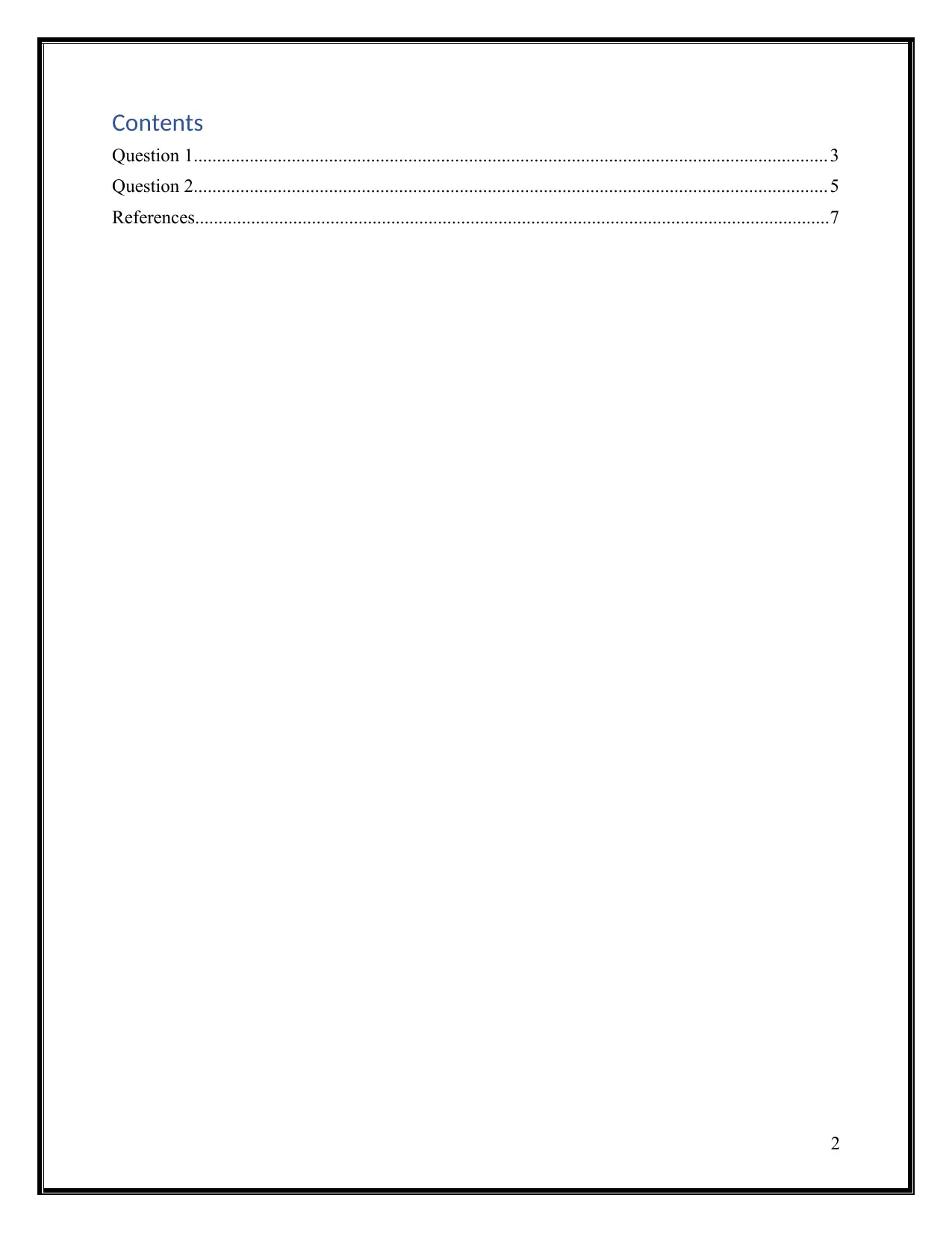
Contents
Question 1........................................................................................................................................ 3
Question 2........................................................................................................................................ 5
References........................................................................................................................................7
2
Question 1........................................................................................................................................ 3
Question 2........................................................................................................................................ 5
References........................................................................................................................................7
2
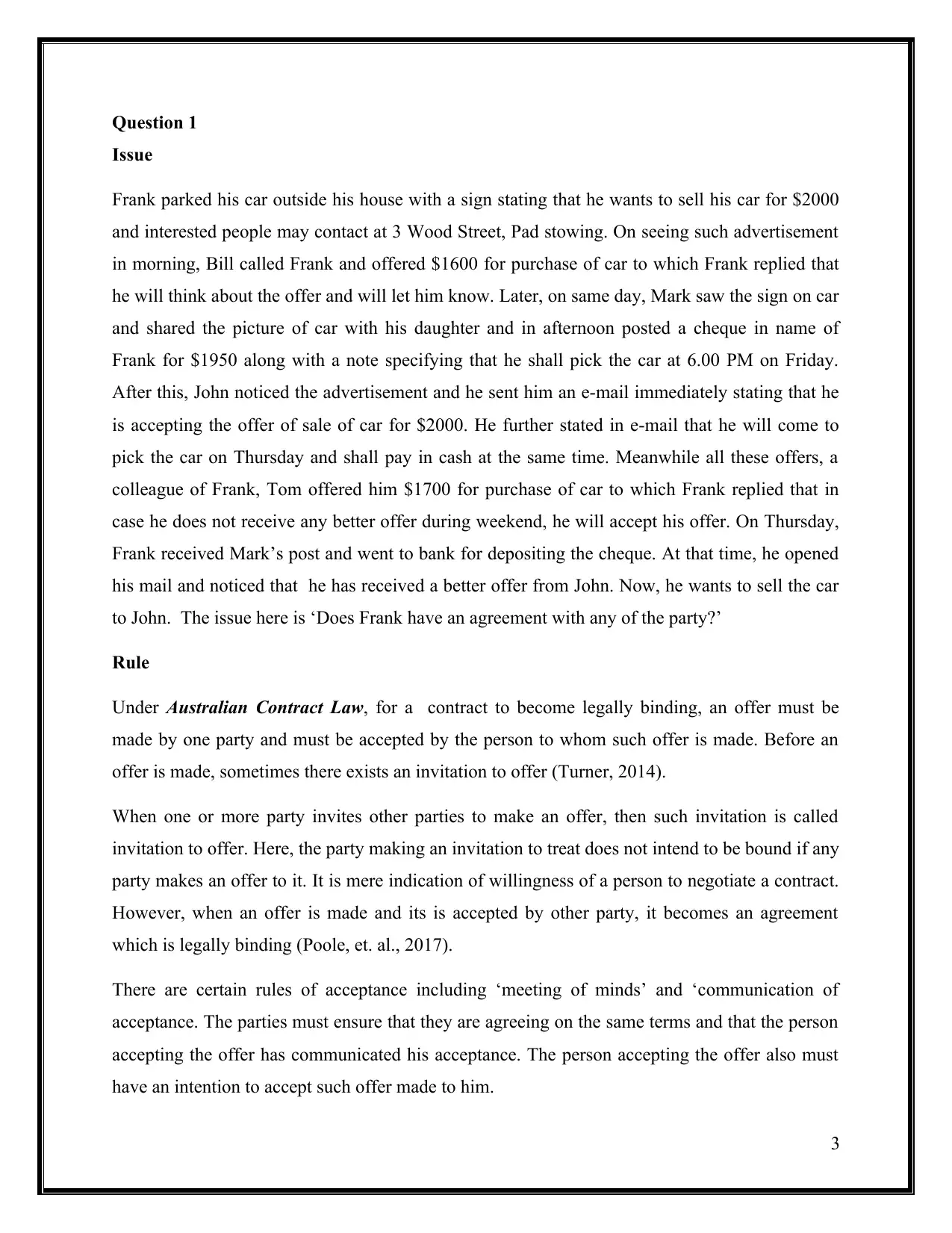
Question 1
Issue
Frank parked his car outside his house with a sign stating that he wants to sell his car for $2000
and interested people may contact at 3 Wood Street, Pad stowing. On seeing such advertisement
in morning, Bill called Frank and offered $1600 for purchase of car to which Frank replied that
he will think about the offer and will let him know. Later, on same day, Mark saw the sign on car
and shared the picture of car with his daughter and in afternoon posted a cheque in name of
Frank for $1950 along with a note specifying that he shall pick the car at 6.00 PM on Friday.
After this, John noticed the advertisement and he sent him an e-mail immediately stating that he
is accepting the offer of sale of car for $2000. He further stated in e-mail that he will come to
pick the car on Thursday and shall pay in cash at the same time. Meanwhile all these offers, a
colleague of Frank, Tom offered him $1700 for purchase of car to which Frank replied that in
case he does not receive any better offer during weekend, he will accept his offer. On Thursday,
Frank received Mark’s post and went to bank for depositing the cheque. At that time, he opened
his mail and noticed that he has received a better offer from John. Now, he wants to sell the car
to John. The issue here is ‘Does Frank have an agreement with any of the party?’
Rule
Under Australian Contract Law, for a contract to become legally binding, an offer must be
made by one party and must be accepted by the person to whom such offer is made. Before an
offer is made, sometimes there exists an invitation to offer (Turner, 2014).
When one or more party invites other parties to make an offer, then such invitation is called
invitation to offer. Here, the party making an invitation to treat does not intend to be bound if any
party makes an offer to it. It is mere indication of willingness of a person to negotiate a contract.
However, when an offer is made and its is accepted by other party, it becomes an agreement
which is legally binding (Poole, et. al., 2017).
There are certain rules of acceptance including ‘meeting of minds’ and ‘communication of
acceptance. The parties must ensure that they are agreeing on the same terms and that the person
accepting the offer has communicated his acceptance. The person accepting the offer also must
have an intention to accept such offer made to him.
3
Issue
Frank parked his car outside his house with a sign stating that he wants to sell his car for $2000
and interested people may contact at 3 Wood Street, Pad stowing. On seeing such advertisement
in morning, Bill called Frank and offered $1600 for purchase of car to which Frank replied that
he will think about the offer and will let him know. Later, on same day, Mark saw the sign on car
and shared the picture of car with his daughter and in afternoon posted a cheque in name of
Frank for $1950 along with a note specifying that he shall pick the car at 6.00 PM on Friday.
After this, John noticed the advertisement and he sent him an e-mail immediately stating that he
is accepting the offer of sale of car for $2000. He further stated in e-mail that he will come to
pick the car on Thursday and shall pay in cash at the same time. Meanwhile all these offers, a
colleague of Frank, Tom offered him $1700 for purchase of car to which Frank replied that in
case he does not receive any better offer during weekend, he will accept his offer. On Thursday,
Frank received Mark’s post and went to bank for depositing the cheque. At that time, he opened
his mail and noticed that he has received a better offer from John. Now, he wants to sell the car
to John. The issue here is ‘Does Frank have an agreement with any of the party?’
Rule
Under Australian Contract Law, for a contract to become legally binding, an offer must be
made by one party and must be accepted by the person to whom such offer is made. Before an
offer is made, sometimes there exists an invitation to offer (Turner, 2014).
When one or more party invites other parties to make an offer, then such invitation is called
invitation to offer. Here, the party making an invitation to treat does not intend to be bound if any
party makes an offer to it. It is mere indication of willingness of a person to negotiate a contract.
However, when an offer is made and its is accepted by other party, it becomes an agreement
which is legally binding (Poole, et. al., 2017).
There are certain rules of acceptance including ‘meeting of minds’ and ‘communication of
acceptance. The parties must ensure that they are agreeing on the same terms and that the person
accepting the offer has communicated his acceptance. The person accepting the offer also must
have an intention to accept such offer made to him.
3
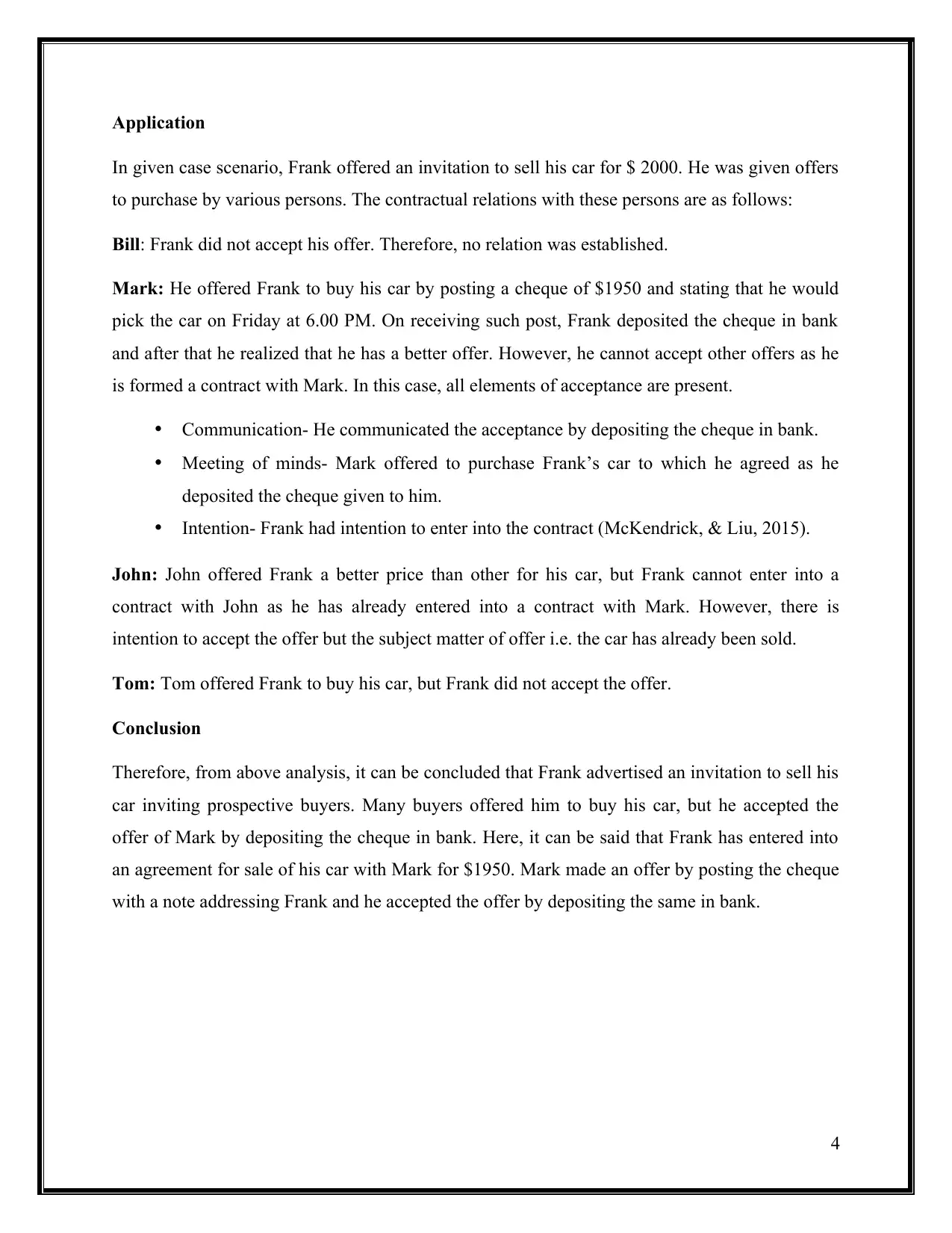
Application
In given case scenario, Frank offered an invitation to sell his car for $ 2000. He was given offers
to purchase by various persons. The contractual relations with these persons are as follows:
Bill: Frank did not accept his offer. Therefore, no relation was established.
Mark: He offered Frank to buy his car by posting a cheque of $1950 and stating that he would
pick the car on Friday at 6.00 PM. On receiving such post, Frank deposited the cheque in bank
and after that he realized that he has a better offer. However, he cannot accept other offers as he
is formed a contract with Mark. In this case, all elements of acceptance are present.
Communication- He communicated the acceptance by depositing the cheque in bank.
Meeting of minds- Mark offered to purchase Frank’s car to which he agreed as he
deposited the cheque given to him.
Intention- Frank had intention to enter into the contract (McKendrick, & Liu, 2015).
John: John offered Frank a better price than other for his car, but Frank cannot enter into a
contract with John as he has already entered into a contract with Mark. However, there is
intention to accept the offer but the subject matter of offer i.e. the car has already been sold.
Tom: Tom offered Frank to buy his car, but Frank did not accept the offer.
Conclusion
Therefore, from above analysis, it can be concluded that Frank advertised an invitation to sell his
car inviting prospective buyers. Many buyers offered him to buy his car, but he accepted the
offer of Mark by depositing the cheque in bank. Here, it can be said that Frank has entered into
an agreement for sale of his car with Mark for $1950. Mark made an offer by posting the cheque
with a note addressing Frank and he accepted the offer by depositing the same in bank.
4
In given case scenario, Frank offered an invitation to sell his car for $ 2000. He was given offers
to purchase by various persons. The contractual relations with these persons are as follows:
Bill: Frank did not accept his offer. Therefore, no relation was established.
Mark: He offered Frank to buy his car by posting a cheque of $1950 and stating that he would
pick the car on Friday at 6.00 PM. On receiving such post, Frank deposited the cheque in bank
and after that he realized that he has a better offer. However, he cannot accept other offers as he
is formed a contract with Mark. In this case, all elements of acceptance are present.
Communication- He communicated the acceptance by depositing the cheque in bank.
Meeting of minds- Mark offered to purchase Frank’s car to which he agreed as he
deposited the cheque given to him.
Intention- Frank had intention to enter into the contract (McKendrick, & Liu, 2015).
John: John offered Frank a better price than other for his car, but Frank cannot enter into a
contract with John as he has already entered into a contract with Mark. However, there is
intention to accept the offer but the subject matter of offer i.e. the car has already been sold.
Tom: Tom offered Frank to buy his car, but Frank did not accept the offer.
Conclusion
Therefore, from above analysis, it can be concluded that Frank advertised an invitation to sell his
car inviting prospective buyers. Many buyers offered him to buy his car, but he accepted the
offer of Mark by depositing the cheque in bank. Here, it can be said that Frank has entered into
an agreement for sale of his car with Mark for $1950. Mark made an offer by posting the cheque
with a note addressing Frank and he accepted the offer by depositing the same in bank.
4
Secure Best Marks with AI Grader
Need help grading? Try our AI Grader for instant feedback on your assignments.
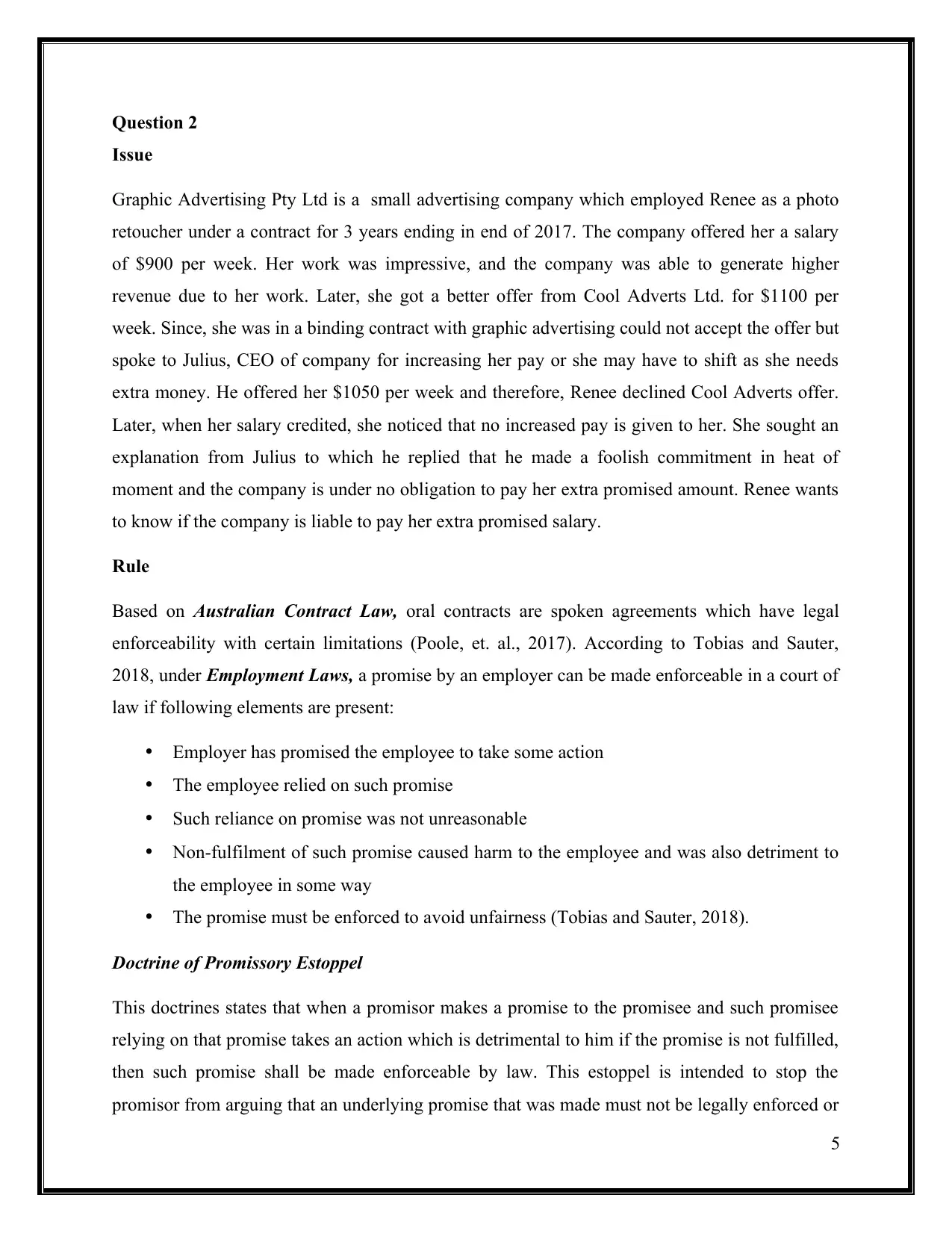
Question 2
Issue
Graphic Advertising Pty Ltd is a small advertising company which employed Renee as a photo
retoucher under a contract for 3 years ending in end of 2017. The company offered her a salary
of $900 per week. Her work was impressive, and the company was able to generate higher
revenue due to her work. Later, she got a better offer from Cool Adverts Ltd. for $1100 per
week. Since, she was in a binding contract with graphic advertising could not accept the offer but
spoke to Julius, CEO of company for increasing her pay or she may have to shift as she needs
extra money. He offered her $1050 per week and therefore, Renee declined Cool Adverts offer.
Later, when her salary credited, she noticed that no increased pay is given to her. She sought an
explanation from Julius to which he replied that he made a foolish commitment in heat of
moment and the company is under no obligation to pay her extra promised amount. Renee wants
to know if the company is liable to pay her extra promised salary.
Rule
Based on Australian Contract Law, oral contracts are spoken agreements which have legal
enforceability with certain limitations (Poole, et. al., 2017). According to Tobias and Sauter,
2018, under Employment Laws, a promise by an employer can be made enforceable in a court of
law if following elements are present:
Employer has promised the employee to take some action
The employee relied on such promise
Such reliance on promise was not unreasonable
Non-fulfilment of such promise caused harm to the employee and was also detriment to
the employee in some way
The promise must be enforced to avoid unfairness (Tobias and Sauter, 2018).
Doctrine of Promissory Estoppel
This doctrines states that when a promisor makes a promise to the promisee and such promisee
relying on that promise takes an action which is detrimental to him if the promise is not fulfilled,
then such promise shall be made enforceable by law. This estoppel is intended to stop the
promisor from arguing that an underlying promise that was made must not be legally enforced or
5
Issue
Graphic Advertising Pty Ltd is a small advertising company which employed Renee as a photo
retoucher under a contract for 3 years ending in end of 2017. The company offered her a salary
of $900 per week. Her work was impressive, and the company was able to generate higher
revenue due to her work. Later, she got a better offer from Cool Adverts Ltd. for $1100 per
week. Since, she was in a binding contract with graphic advertising could not accept the offer but
spoke to Julius, CEO of company for increasing her pay or she may have to shift as she needs
extra money. He offered her $1050 per week and therefore, Renee declined Cool Adverts offer.
Later, when her salary credited, she noticed that no increased pay is given to her. She sought an
explanation from Julius to which he replied that he made a foolish commitment in heat of
moment and the company is under no obligation to pay her extra promised amount. Renee wants
to know if the company is liable to pay her extra promised salary.
Rule
Based on Australian Contract Law, oral contracts are spoken agreements which have legal
enforceability with certain limitations (Poole, et. al., 2017). According to Tobias and Sauter,
2018, under Employment Laws, a promise by an employer can be made enforceable in a court of
law if following elements are present:
Employer has promised the employee to take some action
The employee relied on such promise
Such reliance on promise was not unreasonable
Non-fulfilment of such promise caused harm to the employee and was also detriment to
the employee in some way
The promise must be enforced to avoid unfairness (Tobias and Sauter, 2018).
Doctrine of Promissory Estoppel
This doctrines states that when a promisor makes a promise to the promisee and such promisee
relying on that promise takes an action which is detrimental to him if the promise is not fulfilled,
then such promise shall be made enforceable by law. This estoppel is intended to stop the
promisor from arguing that an underlying promise that was made must not be legally enforced or
5
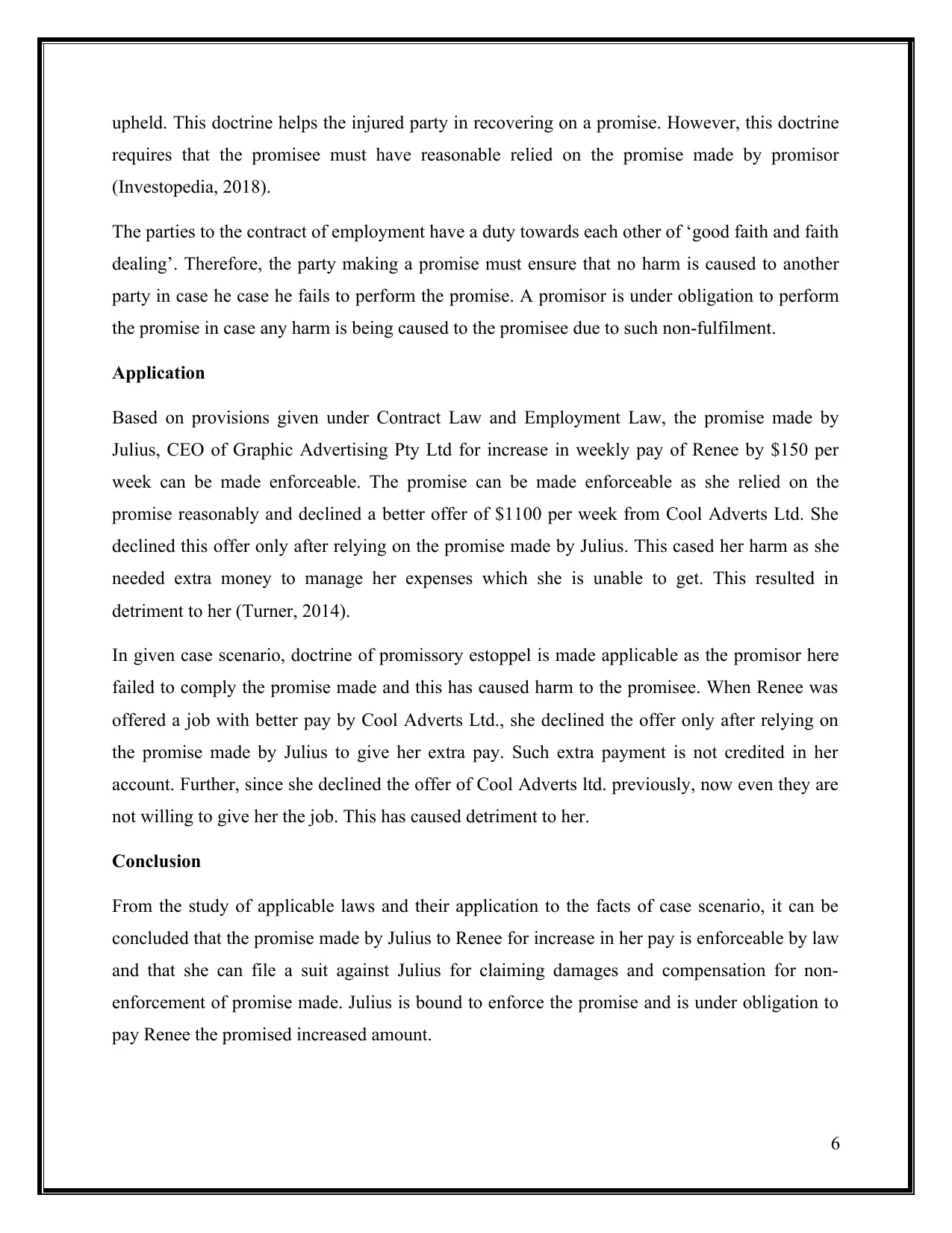
upheld. This doctrine helps the injured party in recovering on a promise. However, this doctrine
requires that the promisee must have reasonable relied on the promise made by promisor
(Investopedia, 2018).
The parties to the contract of employment have a duty towards each other of ‘good faith and faith
dealing’. Therefore, the party making a promise must ensure that no harm is caused to another
party in case he case he fails to perform the promise. A promisor is under obligation to perform
the promise in case any harm is being caused to the promisee due to such non-fulfilment.
Application
Based on provisions given under Contract Law and Employment Law, the promise made by
Julius, CEO of Graphic Advertising Pty Ltd for increase in weekly pay of Renee by $150 per
week can be made enforceable. The promise can be made enforceable as she relied on the
promise reasonably and declined a better offer of $1100 per week from Cool Adverts Ltd. She
declined this offer only after relying on the promise made by Julius. This cased her harm as she
needed extra money to manage her expenses which she is unable to get. This resulted in
detriment to her (Turner, 2014).
In given case scenario, doctrine of promissory estoppel is made applicable as the promisor here
failed to comply the promise made and this has caused harm to the promisee. When Renee was
offered a job with better pay by Cool Adverts Ltd., she declined the offer only after relying on
the promise made by Julius to give her extra pay. Such extra payment is not credited in her
account. Further, since she declined the offer of Cool Adverts ltd. previously, now even they are
not willing to give her the job. This has caused detriment to her.
Conclusion
From the study of applicable laws and their application to the facts of case scenario, it can be
concluded that the promise made by Julius to Renee for increase in her pay is enforceable by law
and that she can file a suit against Julius for claiming damages and compensation for non-
enforcement of promise made. Julius is bound to enforce the promise and is under obligation to
pay Renee the promised increased amount.
6
requires that the promisee must have reasonable relied on the promise made by promisor
(Investopedia, 2018).
The parties to the contract of employment have a duty towards each other of ‘good faith and faith
dealing’. Therefore, the party making a promise must ensure that no harm is caused to another
party in case he case he fails to perform the promise. A promisor is under obligation to perform
the promise in case any harm is being caused to the promisee due to such non-fulfilment.
Application
Based on provisions given under Contract Law and Employment Law, the promise made by
Julius, CEO of Graphic Advertising Pty Ltd for increase in weekly pay of Renee by $150 per
week can be made enforceable. The promise can be made enforceable as she relied on the
promise reasonably and declined a better offer of $1100 per week from Cool Adverts Ltd. She
declined this offer only after relying on the promise made by Julius. This cased her harm as she
needed extra money to manage her expenses which she is unable to get. This resulted in
detriment to her (Turner, 2014).
In given case scenario, doctrine of promissory estoppel is made applicable as the promisor here
failed to comply the promise made and this has caused harm to the promisee. When Renee was
offered a job with better pay by Cool Adverts Ltd., she declined the offer only after relying on
the promise made by Julius to give her extra pay. Such extra payment is not credited in her
account. Further, since she declined the offer of Cool Adverts ltd. previously, now even they are
not willing to give her the job. This has caused detriment to her.
Conclusion
From the study of applicable laws and their application to the facts of case scenario, it can be
concluded that the promise made by Julius to Renee for increase in her pay is enforceable by law
and that she can file a suit against Julius for claiming damages and compensation for non-
enforcement of promise made. Julius is bound to enforce the promise and is under obligation to
pay Renee the promised increased amount.
6
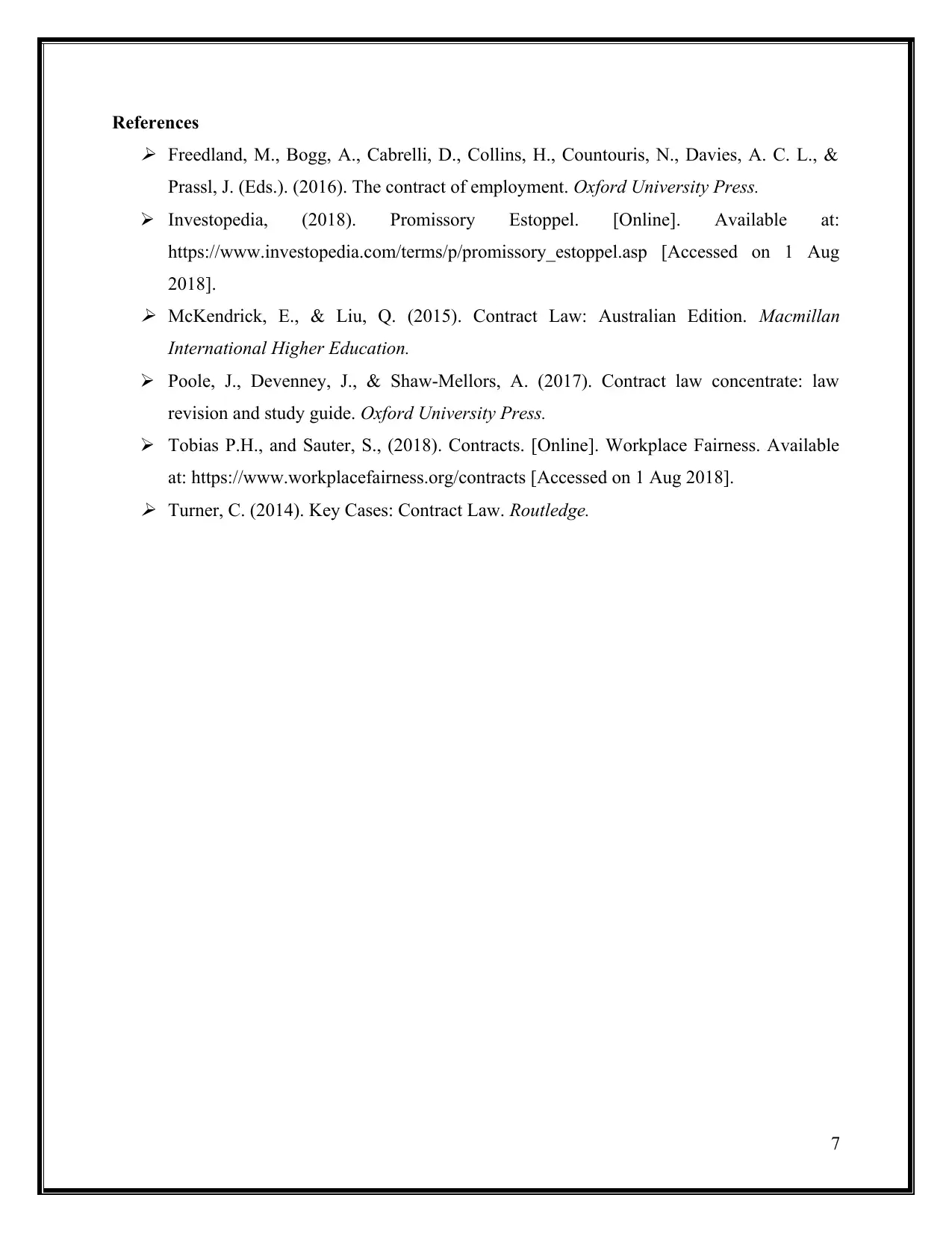
References
Freedland, M., Bogg, A., Cabrelli, D., Collins, H., Countouris, N., Davies, A. C. L., &
Prassl, J. (Eds.). (2016). The contract of employment. Oxford University Press.
Investopedia, (2018). Promissory Estoppel. [Online]. Available at:
https://www.investopedia.com/terms/p/promissory_estoppel.asp [Accessed on 1 Aug
2018].
McKendrick, E., & Liu, Q. (2015). Contract Law: Australian Edition. Macmillan
International Higher Education.
Poole, J., Devenney, J., & Shaw-Mellors, A. (2017). Contract law concentrate: law
revision and study guide. Oxford University Press.
Tobias P.H., and Sauter, S., (2018). Contracts. [Online]. Workplace Fairness. Available
at: https://www.workplacefairness.org/contracts [Accessed on 1 Aug 2018].
Turner, C. (2014). Key Cases: Contract Law. Routledge.
7
Freedland, M., Bogg, A., Cabrelli, D., Collins, H., Countouris, N., Davies, A. C. L., &
Prassl, J. (Eds.). (2016). The contract of employment. Oxford University Press.
Investopedia, (2018). Promissory Estoppel. [Online]. Available at:
https://www.investopedia.com/terms/p/promissory_estoppel.asp [Accessed on 1 Aug
2018].
McKendrick, E., & Liu, Q. (2015). Contract Law: Australian Edition. Macmillan
International Higher Education.
Poole, J., Devenney, J., & Shaw-Mellors, A. (2017). Contract law concentrate: law
revision and study guide. Oxford University Press.
Tobias P.H., and Sauter, S., (2018). Contracts. [Online]. Workplace Fairness. Available
at: https://www.workplacefairness.org/contracts [Accessed on 1 Aug 2018].
Turner, C. (2014). Key Cases: Contract Law. Routledge.
7
1 out of 7
Related Documents
Your All-in-One AI-Powered Toolkit for Academic Success.
+13062052269
info@desklib.com
Available 24*7 on WhatsApp / Email
![[object Object]](/_next/static/media/star-bottom.7253800d.svg)
Unlock your academic potential
© 2024 | Zucol Services PVT LTD | All rights reserved.





